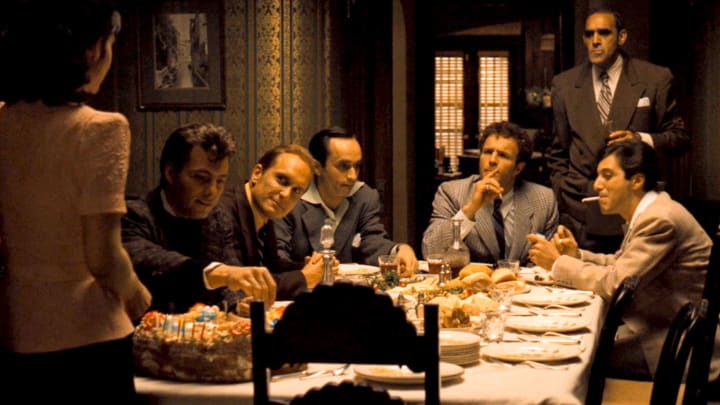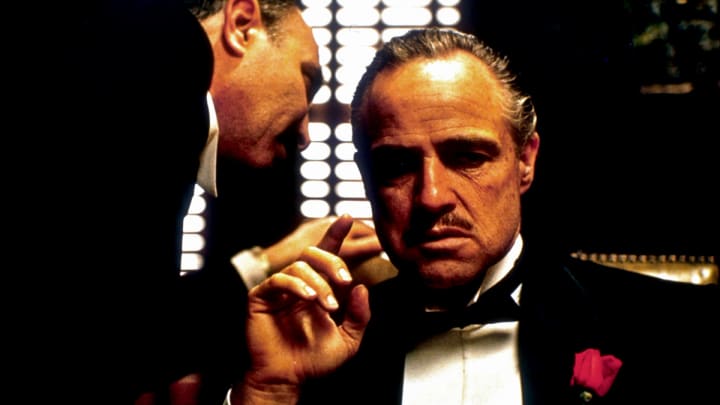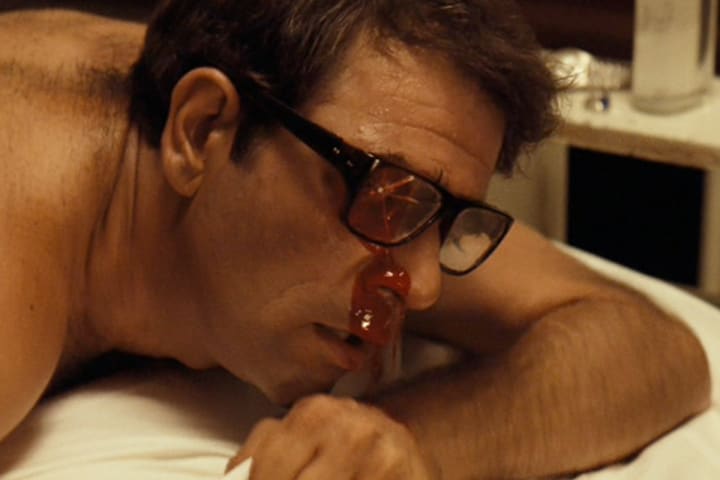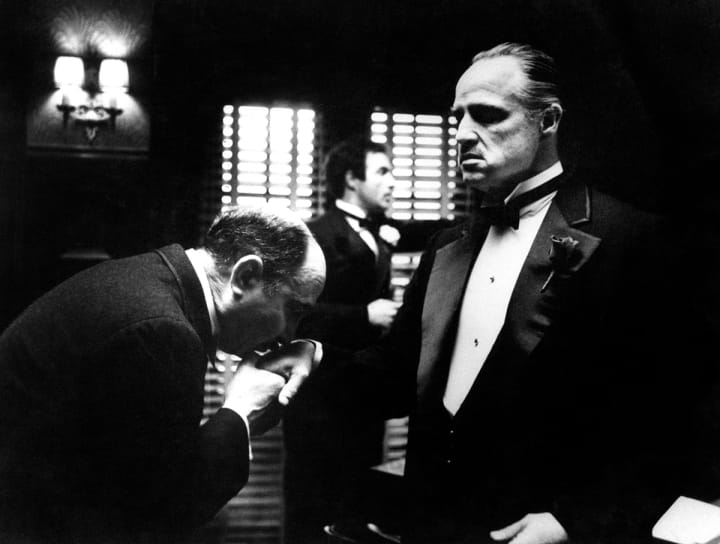What Family Is the Corleone Family Based on
Is 'The Godfather' Based On a Truthful Story?
Which aspects of the classic mob tale are objects of Mario Puzo'south imagination, and which are rooted in fact?
Mario Puzo nigh never wrote The Godfather. At the age of forty-five, his writing career was going downhill fast. He had made little money on his published works, and was receiving little support from publishers regarding his latest pitch—a novel near Italian-Americans in organized criminal offense. When the book was completed, it became one of the nearly remarkable successes in literary and cinematic history, with quotes from Francis Coppola'south film adaptation entering the American dictionary and quickly becoming widely recognizable.
As millions of Americans started telling each other they'd make "an offer they can't refuse," and to "never take sides against the family," many were left wondering only how much truth there was behind the depictions of these powerful families. Many gangsters assumed that Puzo got his accounts from commencement-paw relationships. This is impressive because Puzo himself stated, "I'm aback to admit that I wrote The Godfather entirely from enquiry. I never met a existent honest-to-God gangster. I knew the gambling world pretty practiced, just that's all." His research must have been well-done, as he also stated that many of the gangsters he met afterwards the book was published "refused to believe that I had never been in the rackets. But all of them loved the book."
That being said, many aspects of the book are at the very least based on real life Mafia families and their business in New York in the 1940s.
The Families

The concept of the five families of New York is most certainly based on fact. While each Boss and his family draws characteristics from the real-life New York families, in that location don't seem to exist any clear-cut associations betwixt one family and the other. For example, the Tattaglia family in The Godfather and the real-life Gambino family were both known for their concern in prostitution. However, Boss Philip Tattaglia is said to be based more than on Tommy Lucchese than on a Gambino boss or family unit member.
The five families of The Godfather are:
- The Corleone family
- The Tattaglia family
- The Barzini family
- The Cuneo family
- The Stracci family unit
The v families of New York City are:
- The Genovese family
- The Gambino family
- The Lucchese family
- The Colombo family
- The Bonanno family
The Commission
The Commission, or the governing body of the Mafia, is another familial concept presented in The Godfather that had a potent ground in fact. Both in the motion-picture show and in existent life, the Commission is responsible for settling disputes betwixt families and approving new members and bosses. Only the Committee has the power to remove a boss from power, though both the fictional and factional accounts have seen many a rogue murder of a Don.
The Characters

Vito Corleone
Don Vito Corleone actually shared a likeness to many a Mafioso from the v families of New York. It is hard to narrow down a singular inspiration behind this grapheme. His demeanor was similar to that of Joseph Bonanno, while his legitimate front-business was olive oil, like Joseph Profaci. His influence rivaled that of Carlo Gambino, ane of the most powerful bosses of the 60s and 70s. His reluctance to tolerate and support the drug trade can also be said to reference Gambino, as the Gambino family unit had very strict rules confronting drug trafficking inside its family. Violating these rules was punishable past death, with "Bargain and die" beingness the steadfast rule of the family. Vito also shared Gambino'southward familial structure, having 3 sons and a daughter, and both died of a centre assault at age seventy-half dozen.
Frank Costello, of the Luciano/Genovese offense family unit, resembled Corleone on a deeper level as well. Much of Corleone's power was derived from his business concern and connections, and it is this aspect of his business that most mimicked Costello'south life. They both preferred to reason out a situation when possible, resorting to bloodshed as merely a last resort. Vito shared a nascency yr with Costello, and both earned a large chunk of their fortunes through gambling and bootlegging.
Johnny Fontaine
Few movie characters take ever been then transparently based upon a existent-life celebrity as Johnny Fontaine. His correlation to Frank Sinatra was not easily lost on audiences. The neighborhood vocaliser was rescued from an unfair contract by a friend with mob connections. Sinatra's underworld connections are legendary, with J. Edgar Hoover stating that he had a "hoodlum complex." Both actors had their careers saved by roles in war films (though Sinatra did not have to put a horse caput into the studio boss' sheets to get the office). While Sinatra was never accused of racketeering and does non seem to take actively participated in mob activities, he was certainly a groupie of sorts. He also was briefly considered for the office of Vito Corleone, and reportedly had discussions to that effect with Coppola.
Luca Brasi
Willie Moretti was reportedly the friend that got Sinatra out of his bad contract with bandleader Tommy Dorsey. This is his most direct connexion with grapheme Luca Brasi, who does the same for Johnny Fontaine. Moretti was not known to be every bit barbarous or sociopathic as Brasi was in Puzo'due south retelling, but the two met the same finish at the hands of their bosses. Moretti was executed for condign too talkative, and the killing was seen every bit a necessary component to loosening the grip that his cousin Frank Costello had on the Genovese family and left room for the Gambino family to have charge. Likewise, Brasi's death softened the Corleone family and opened them up to exploitation from the Tattaglia and Barzini families.
Michael Corleone
There is no known pure influence for the character of Michael Corleone. Notwithstanding, at that place are a couple of partial influences. Much like Michael, Salvatore "Neb" Bonanno'due south father sent him to police force school and tried to encourage him to alive a legitimate life. Like Michael, Beak ends up becoming involved in the family business anyways. However, their legacies inside their families couldn't exist more unlike. Bill was never accepted by the men on the street, and was a huge muck-up. Bill also had fiddling existence and success in the directly world, while Michael steered his family through a legitimate life while maintaining his crime career. Vito Genovese also provided some influence, every bit he fled to Italy in 1937 to escape murder charges.
Emilio Barzini
Emilio Barzini was less savage and more urbane than Vito Genovese, but the influence is most certainly at that place. They shared a mercenary nature and a hubris that led them to believe they were the "Capo di tuti capi," the "Dominate of bosses." Where other bosses ruled under honor and traditions, Barzini and Genovese both preferred to practise things their own way. Ultimately, the civilisation they disavowed was holding the fabric of their families together, and their refusal to abide by it led to their downfall.
Moe Greene
The grapheme of Moe Greene was strongly inspired by Bugsy Siegel. Siegel was an executioner for "Murder, Inc.," the group of New York based Jewish and Irish killers that the Italian mob developed to outsource some of their work. Afterward existence sent to Los Angeles on business, he built some relationships with Hollywood stars, namely Clark Gable and Frank Sinatra. At the time, Las Vegas was a sleazy town, just Siegel saw the potential for it to get a glamorous tourist destination. Siegel called Meyer Lansky (the inspiration for Hyman Roth, see below), the mob's "numbers guy," to bankroll his project, ownership the Flamingo, a luxury casino, and entertainment complex. While the people came, revenues did not make their way back to Siegel'due south backers as speedily equally they believed they should. He overshot his budgets, despite warnings, and failed to plough a turn a profit even subsequently the casino opened. Lansky became convinced that Siegel was skimming, and finally agreed that he had to go. On June 17, 1947, Siegel was killed at the home of his mistress.
Moe Green is killed more than for his public embarrassment of the Corleone family than for skimming, but his backstory and his ultimate demise bear an uncanny resemblance to that of Siegel.
Salvatore Tessio
Just like his existent-life inspiration, Gaspare DiGregorio, Salvatore Tessio was a trusted captain of his family unit. He was immensely powerful inside the Bonanno family unit. Notwithstanding, when Bonanno promoted his son instead of DiGregorio, the helm felt slighted. He enlisted the service of other bosses to hatch a plot confronting Bonnano, outset a war between the families that the press would championship the "Banana War.
Much in the same fashion, Tessio set the assassination of Michael Corleone. Nonetheless, the similarities stop there. Tessio is caught before an assault tin can exist made, whereas DiGregorio and his co-conspirators are successful in at least attempting an attack. Every shot missed its target, however, and DiGregorio was retired in one case the other bosses found a suitable replacement for him.
Hyman Roth
Hyman Roth is introduced in The Godfather, Part 2, and his partnership with Don Vito mimics that of the relationship between Meyer Lansky and Lucky Luciano and Frank Costello. Lansky was a financial genius and was responsible for much of the success of organized offense in his time. Many large names among the families, the aforementioned included, greatly valued his counsel. Only as his real-life analogue realized the need for Bugsy Siegel'southward execution, Lansky understood that he must concur to the assassination of Moe Green. In fact, the line "We're bigger than US Steel," uttered by Roth in the film, has long been attributed to Lansky. However, while Roth was shot past a Corleone operative, Lanksy lived a long life in S Florida. Roth's liaison to the Mafia, Johnny Ola, was too modeled on Lansky'southward liaison, named Vincent Alo.
Joey Zasa
Many take attributed the inspiration for Joey Zasa of The Godfather, Part iii to John Gotti. While Gotti was followed heavily past mainstream media at the time that the third installment of the serial was being adult, the truthful inspiration for Zasa was Joseph Colombo. Both men created organizations designed to highlight the positive aspects of the Italian-American customs. In fact, Colombo's Italian-American Ceremonious Rights League succeeded in ensuring that Paramount Pictures did not use the word "mafia" in the series that would mimic his deportment on screen. Both were as well assassinated during their ain organizations' unity rallies.
The Stories

Moe Dark-green's Death
Moe Green/Bugsy Siegel put Vegas on the map, but their inabilities to plough profit angered many businessmen. Siegel was shot in the head, with the bullet coming out the forepart through his eye. Moe Light-green was shot in his center itself, certainly a tribute to his inspiration'due south downfall. The Mafia took over the operations of the Flamingo after Siegel'due south expiry just every bit the Corleones took over later Greene's death.
Michael Corleone's Eatery Hit
In The Godfather, later meeting two of his father'due south enemies in a restaurant, Michael takes them out by shooting them with a gun he had planted in the bathroom. In 1931, Lucky Luciano's boss Joe Masseria met him at an Italian restaurant. When Luciano excused himself to go to the bath, Masseria'due south hit men barged into the eating house, shot Masseria, and left.
The Horse's Head
The scene of a producer waking up to notice his thoroughbred's caput in his sheets was not inspired past truthful events (at least not that my research revealed). Nonetheless, it led to many an instance of life imitating art. For case, in 2008, Mafia enforcers left the severed donkey's head as a alarm to a baker who refused to pay protection money in Villafranca Padovana, Italy, equally a tribute to the infamous scene.
The Perception

Stereotyping
The Godfather, much like The Sopranos, gave a detailed portrait of Italian American life. However, while both tributes focused on traditions of loyalty and family unit, they also both focused on mob families. This led to many mixed feelings amid Italian American families that were already battling stereotypes and trying to brand their way in a new country. In 1970, the Italian American Civil Rights League held a rally to stop product of The Godfather for its negative portrayal of Italian Americans. However, the flick, along with like movies and shows of its time, gave many Italian Americans a sense of shared identity and experience, and enthralled Italians as much as it did not-Italians.
Dons Comprehend The Godfather
Many mobsters saw Puzo's portrayal of the Mafia as a badge of honor, and worked to live upwards to it. Many would emulate the crimes Puzo wrote, embracing them as their ain and further enforcing the picture that Puzo painted. Notorious drug dealer Griselda Blanco christened her youngest son Michael Corleone, according to a 2001 Daily Mirror article.
While many gangsters tried to finish the cosmos of The Godfather, once it was released they figured they might as well play the office that was created for them. American law enforcement officials regularly detect copies of The Godfather while searching mobsters' homes. After the film was released, Mafiosi began speaking like the characters, to the point that law enforcement personnel said it made phone taps and other surveillance techniques more entertaining. The Godfather had the benefit of being told from a unlike perspective than most gangster films of its fourth dimension—for the first time the thoughts and feelings of the gang members were taken into account. Don Corleone is an honorable man, ruthless with his enemies but devoted to his family.
Diego Gambetta's 2009 book Codes of the Underworld: How Criminals Communicate institute that many gangs employ the film as a preparation tool. By setting out to capture the life of a gangster authentically, The Godfather now shapes today'southward criminals. Equally Sammy the Bull put it as he reflected on the legendary eating place scene:
"Remember how Michael couldn't hear anything equally he's walking up on them? Remember how his eyes went glassy, and in that location was merely the dissonance of the train in the background, and how he couldn't hear them talk? That'south just similar I felt when I killed Joe Colucci. Somebody who wrote that scene had to have a feeling for that. I mean, I felt like I was pulling the trigger myself.
fact or fictionindustrymovie
Chelsea Lynne
Enthusiastic bunny lover. Member of Nutrition Coke anonymous. Still trying to figure out what Blazon B means.
Source: https://vocal.media/geeks/is-the-godfather-based-on-a-true-story
0 Response to "What Family Is the Corleone Family Based on"
Postar um comentário